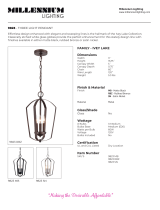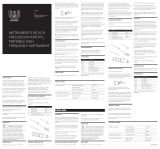Page is loading ...

14 InPro 48XX Series pH electrode
InPro 48XX Series pH electrode © 03 / 16 Mettler-Toledo GmbH
52 002 134 Printed in Switzerland
1 Introduction ...................................................................15
2 Safetyinstructions ..........................................................15
3 Product description .........................................................15
4 Installation and commissioning .......................................16
5 Operation:Calibrationoftheelectrode
and pH transmitter ..........................................................16
6 Maintenance ..................................................................16
7 Removalofsourcesofmalfunction ..................................17
8 Disposal ........................................................................17
9 Guarantee ......................................................................17
10 Storage conditions ..........................................................17
Contents
en
InPro 48XX Series
pH Electrode
Instruction Manual
InPro and ISM are registered trademarks of
Mettler-ToledoGmbHinSwitzerland,theUSA,
theEuropeanUnionandafurthervecountries.
en Instruction Manual

InPro 48XX Series pH electrode 15
© 03 / 16 Mettler-Toledo GmbH InPro 48XX Series pH electrode
Printed in Switzerland 52 002 134
1 Introduction
The METTLER TOLEDO InPro
®
48XX pH-single rod
measuringcellisalowmaintenance,high-pressure
resistantpHelectrodewithapressurecompensated
doublechambersystemusingagelelectrolyteand
areferencesystemtogetherwithasilverionsbarrier.
Please read through these operating instructions
carefully before commissioning, in order to ensure
trouble-free use.
2 Safety instructions
When cleaning or calibrating the electrode using
solutionscontainingacidsoralkalisbothprotective
spectaclesandprotectiveglovesshouldbeworn.
Donottouchtheelectrodeattheplug-incontacts,since
electrostaticdischargescandamagetheelectronics.
Werecommendthatyouonlyoperatetheelectrodein
combinationwithoriginalpartsfromMETTLERTOLEDO.
Operation and maintenance should be carried out
only by trained personnel and staff who have read
andunderstoodtheoperatinginstructions.
3 Product description
The inscription on each electrode contains the
followinginformation:
METTLER TOLEDO Manufactureroftheelectrode
InPro
®
48XX i / SG / yyy / zzz / ISM Typedesignation;XX=shaft
material,membraneglass;
i=ISMDigital/SG=ancillary
electrode/yyy=rodlengthin
mm/zzz=typeoftemperature
sensor/ISM(analog)
combination pH Typeofelectrode
pH0…14(InPro4800) pHmeasurementrange
pH1…14(InPro4801/4881)
pH1…11(InPro4802)
– 5 … 130 °C Temperature range for
0…80°C(InPro4802) operation
Order No. 52 00X XXX Order number
SEV14ATEX0168X Identicationandnumber
ofcerticate
IECExSEV14.0025X Identicationandnumber
ofcerticate
IS/I,II,III/1/ABCDEFG/T6 FMtested
Seeinstructionmanual! Instruction(Observethe
operatinginstructions)
In addition each electrode is allocated a serial
numberontheredpartoftheplug-inheadtoenable
identication.
en

16 InPro 48XX Series pH electrode
InPro 48XX Series pH electrode © 03 / 16 Mettler-Toledo GmbH
52 002 134 Printed in Switzerland
4 Installation and commissioning
1. While unpacking check the electrode for
mechanicaldamage.Pleasereportanydamage
immediatelytoyourMETTLERTOLEDOsupplier.
2.Removetheprotectivecapandrinsetheelectrode
for a short time with deionized water. If the
electrodehasalreadybeenusedthesensitivepart
canbecleanedwithasofttoothbrushandamild
soapsolution,andthenrinsedforashorttimewith
deionizedwater.Afterrinsingtheelectrodeshould
onlybedabbed.AnyrubbingofthepHsensitive
glasscanincreasetheresponsetimeasaresult
ofelectrostaticcharge.
3.Check thespace behind the pH sensitive glass
forairbubblesandremoveanyairbubblesthat
maybepresentbyshakingtheelectrodeslightlyin
a vertical direction.
4.Placetheelectrodeintothearmatureasdescribed
intheinstructionsforthearmature.
5.ConnecttheelectrodeandthepHtransmitterwith
thecorrespondingcable(VP6,VP8,AK9).Observe
the connections scheme that accompanies the
cableorthetransmitter.
6. Intelligent ISM
®
sensorssuchasInPro480X(ISM)
and InPro 48XX i enable “Plug and Measure”
and expanded diagnostics. For installation,
commissioningandoperationoftheISMsystem
please refer to instructions for the transmitter,
module and cable.
5 Operation: Calibration of the electrode and
pH transmitter
Before a calibration immerse the electrode for
10minutesinapH7.00orpH4.01buffersolution
whilst connected it to the transmitter. A 2-point
calibration is recommended, e.g. pH 7.00 and pH 4.01
buffersolutions.Forfurtherdetailspleaseconsultthe
operatinginstructionsforthepHtransmitter.
6 Maintenance
1. After each working cycle the electrode tip and
diaphragm have to be carefully rinsed with
deionized water. Any remaning of the solution
beingmeasuredonthesepartsmustbeavoided
at all costs!
2. Iftheelectrodeisnotinuseithastobestoredwith
theelectrodetipandthediaphragmimmersedin
atankofelectrolyte(9823/3MKClorFriscolyt™
9848).).
en

InPro 48XX Series pH electrode 17
© 03 / 16 Mettler-Toledo GmbH InPro 48XX Series pH electrode
Printed in Switzerland 52 002 134
3. If the electrode is stored in its armature the
advicesdescribedunderItem2apply,although
the electrolyte has to be slightly modied for
storagepurposes(2partsofbuffersolutionpH
9.2to10partsofelectrolyte)inordertoavoidany
corrosionofthearmatureparts.
4. If an electrode is inadvertently stored in a dry
conditionfor several days it must berinsedfor
severalhoursinastandardstorageelectrolyte.
5. Theplug-inheadshouldoccasionallybechecked
forpossibletracesofmoisture.Ifnecessaryclean
itthoroughlywithdeionizedwateroralcoholand
thendryitoffcarefully.
7 Removal of sources of malfunction
Withasofttoothbrushandwateranyresiduescan
easilyberemovedfromtheelectrode.Mildwashing
agents can also be used. Protein contaminations on
the diaphragm can be removed with the cleaning
solution(orderno.51340070).
Warning: Solutionscontaininghydrouoridesdamage
thepHsensitivepartoftheelectrode.
8 Disposal
Itistheuser’sresponsibilitytodisposeofthesensor
ina professional manner. The sensorcan contain
electroniccomponentsthatrequiredisposalsuchthat
nopersonsortheenvironmentareendangered.
9 Guarantee
Onmanufacturingdefects12monthsafterdelivery.
10 Storage conditions
Werecommendthattheelectrodesarestoredatroom
temperature.
en

InPro 48XX Series pH electrode 71
© 03 / 16 Mettler-Toledo GmbH InPro 48XX Series pH electrode
Printed in Switzerland 52 002 134
zh
1
- InPro
®
48XX pH-
pH
2
-
3
METTLER TOLEDO
InPro
®
480XX i / SG / yyy / zzz / ISM XX =
i = ISM Digital / SG = /
yyy = mm /
zzz = / ISM
combination pH pH
pH 0
…
14 (InPro 4800) pH
pH 1
…
14
(InPro4801/4881)
pH 1
…
11 (InPro 4802)
– 5
…
130
°
C
0
…
80
°
C (InPro 4802)
Order No. 52 00X XXX
SEV14 ATEX 0168 X
IECEx SEV 14.0025X
IS / I, II, III/1 / ABCDEFG / T6 FM
See instruction manual!

74 InPro 48XX Series pH electrode
InPro 48XX Series pH electrode © 03 / 16 Mettler-Toledo GmbH
52 002 134 Printed in Switzerland
–
Notes

InPro 48XX Series pH electrode 75
© 03 / 16 Mettler-Toledo GmbH InPro 48XX Series pH electrode
Printed in Switzerland 52 002 134
–
Notes

Brazil Mettler-Toledo Ind. e Com. Ltda.
AvenidaTamboré,418–Tamboré,
BR-06460-000Barueri/SP,Brazil
Phone+551141667400
e-mailmettler@mettler.com.br;service@mettler.com.br
France Mettler-Toledo Analyse Industrielle S.A.S.
30,Bld.deDouaumont,FR-75017Paris,France
Phone+33147370600
e-mail mtpro-f@mt.com
Germany Mettler-Toledo GmbH
Prozeßanalytik,Ockerweg3,DE-35396Gießen
Phone+49641507-444
e-mail prozess@mt.com
Switzerland Mettler-Toledo (Schweiz) GmbH
ImLangacher,CH-8606Greifensee
Phone+41449444760
e-mailProSupport.ch@mt.com
United States METTLER TOLEDO
ProcessAnalytics
900 Middlesex Turnpike, Bld. 8, Billerica, MA 01821, USA
Phone+17813018800
Freephone+18003528763(onlyUSA)
e-mail mtprous@mt.com
FormoreaddressesofMETTLERTOLEDOMarketOrganizationspleasegoto:
www.mt.com/pro-MOs
Mettler-ToledoGmbH,ProcessAnalytics,ImHackacker15,CH-8902Urdorf
Phone+41447296211,Fax+41447296636
Subjecttotechnicalchanges
03/2016©Mettler-ToledoGmbH
PrintedinSwitzerland.52002134
www.mt.com/pro
Addresses | Impressum
/


